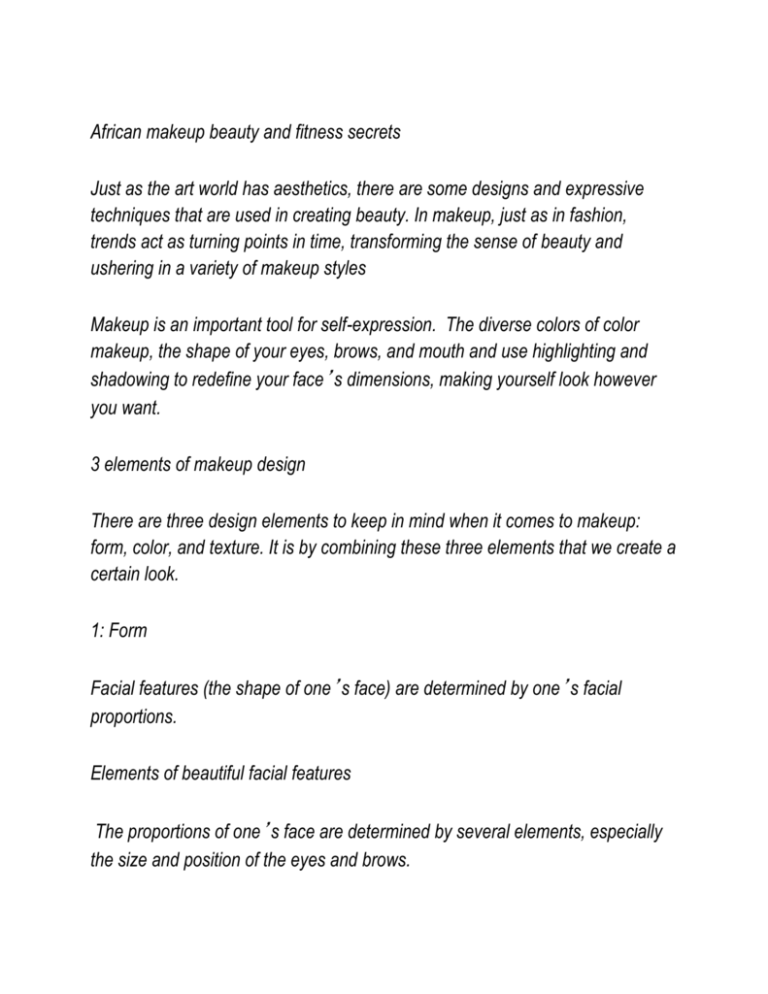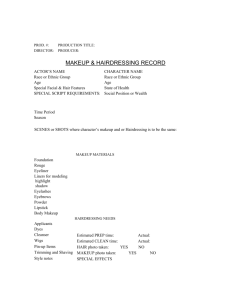African-makeup-beauty-and-fitness-secrets
advertisement

African makeup beauty and fitness secrets Just as the art world has aesthetics, there are some designs and expressive techniques that are used in creating beauty. In makeup, just as in fashion, trends act as turning points in time, transforming the sense of beauty and ushering in a variety of makeup styles Makeup is an important tool for self-expression. The diverse colors of color makeup, the shape of your eyes, brows, and mouth and use highlighting and shadowing to redefine your face’s dimensions, making yourself look however you want. 3 elements of makeup design There are three design elements to keep in mind when it comes to makeup: form, color, and texture. It is by combining these three elements that we create a certain look. 1: Form Facial features (the shape of one’s face) are determined by one’s facial proportions. Elements of beautiful facial features The proportions of one’s face are determined by several elements, especially the size and position of the eyes and brows. P.P.D. effect Bedrock of Kanebo’s makeup theory “P.P.D. effect.” P.P.D. = Parts, Positioning, Dimension This theory helps beauty counselors and makeup artists understand the characteristics of a face in order to propose makeup solutions for customers in the stores.. P.P.D. = Parts, Positioning, Dimension Color When choosing makeup colors, consider not only the shades (hues) themselves but also such elements of color as their tone and how they look in combination with each other. Hue: Hue is one of the main properties of a color that account for its appearance. Neutral hues such as white, gray, and black and colorful hues such as red, yellow, and blue produce a variety of impressions and stimuli. For example, red evokes passionate, blue = sharp, yellow = healthy, and so on. Color tone: Effects of colors in combination: When two or more colors are used alongside each other, each of them is influenced by the other and takes on a different look. For example, wearing bold red lipstick diminishes the appearance of dullness or uneven coloring in the skin. Lightness contrast A dark color can accentuate the brightness of the surrounding color Example: The effect of eyeliner 3: Texture With makeup, we can vary the finished look dramatically by employing colors with different shine, sparkle, and depth. By introducing changes in texture, our design possibilities expand and makeup becomes all the more exciting. There are 3 broad types of makeup textures. Matte: Suppresses light reflection, lending calmness and depth. Has an elegant, refined look Sheer: Creates a festive, glamorous look. Brightens the overall impression of the face or adds impact locally on one part of the face. For those who want to enjoy both color and sparkle Gloss: Evokes a youthful image with a lustrous, dewy-looking shine. Has a vibrant, richly hydrated look For those who want to enjoy the texture more than the color African beauty The use of cosmetics in Ancient Egypt is well documented. Kohl and henna have their roots in North Africa. Remedies to treat wrinkles were recorded at the time of Thutmosis III, containing ingredients such as gum of frankincense and fresh moringa. For scars and burns, a special ointment was made of red ochre, kohl, and sycamore juice. An alternative treatment was a poultice of carob grounds and honey, or an ointment made of frankincense and honey. To improve breath the ancient Africans chewed herbs, frankincense, or licorice root stick, which is still in use today. Jars of what could be compared with 'setting lotion' have been found to contain a mixture of beeswax and resin. These doubled as remedies for problems such as baldness and graying hair. Traditional African techniques of hair maintenance are actually being used as we speak! Here are some new and old favorites: 1. Rooibos Tea This is traditional oil from Mozambique and South Africa. It is popular as a skin moisturizer but can certainly also be processed to a food grade standard and eaten It is also known to contain antioxidants. 3. Rhassoul Clay 4. African Black Soap This is a traditional soap from West Africa and is commonly made from oil (shea butter commonly and plant ash. but it is important to remember that soap is soap and it will always have a high pH. If that is something you are sensitive to, then do not use it. 5. Shea Butter, Avocado Butter, Cocoa Butter, Coconut oil, Argan Oil I. If you are experiencing dry hair, do try to include an oil/butter within your moisturizing routine. 6. Ghee (butter) Additionally, it’s used to strengthen hair which is possible in part due to the fat in butter, much like in coconut oil, is unsaturated 7. African threading It is used in a similar manner and in addition is a way to stretch hair with no heat. 8. Braiding Intricate braiding is a feature of many traditional and modern African communities. There are many African women who traditionally (and in modern day) chose to wear their hair short as it is convenient and fuss free. However, from the Himba women of Southern Africa to Ethiopian tribes of Eastern Africa and even to the Nigerian women of Western Africa, there are many communities who traditionally (and in modern day) showcase long braided hair. Braiding long hair is as much for beauty as shown in the attention to detail as it is for maintenance of hair length. It is a protective style that has withstood the test of time. Consistency. Running - a lot - is the key to distance running, to logging many kilometres day in, day out. Squeeze a few more kilometres into your week, without compromising quality, you will reap the benefits. Train hard. The motto "train hard, win easy “if you want to run hard come race day, it's best to prepare with some sort of speed session (intervals, fartlek, tempo) to the specific effort of your race pace. Rest hard. After bouts of hard training it is vital that the body has time to repair and recover for the next training session and get to bed early. Plus, they don't run hard all the time. Make sure you're not running hard every day and take it easy the day or two after a hard run. Soft surfaces. Running on dirt trails rather than pavement is much easier on the body. Seek out soft surfaces for most of your running, and your body will thank you. Group training. Run in groups during speed sessions as well as their easy runs. Running with a group can provide that extra push during hard runs and it can help keep the easy runs leisurely with chit-chat. Proper warm-up. It's best to ease into your runs, and it is especially important to do some easy jogging before any type of speed session or race. Nutrition. They eat fresh food that usually comes from small-scale farms in their region. Ugali (a cornmeal dish) is their staple carbohydrate of choice and is served with beef or chicken stew and veggies. Hakuna matata. The Lion King popularized the Swahili phrase "hakuna matata" which, loosely, translates to "no worries.". It's important to leave stress behind to allow your body to perform at its best, and sometimes the best way to relieve stress is to head out the door for a run.









